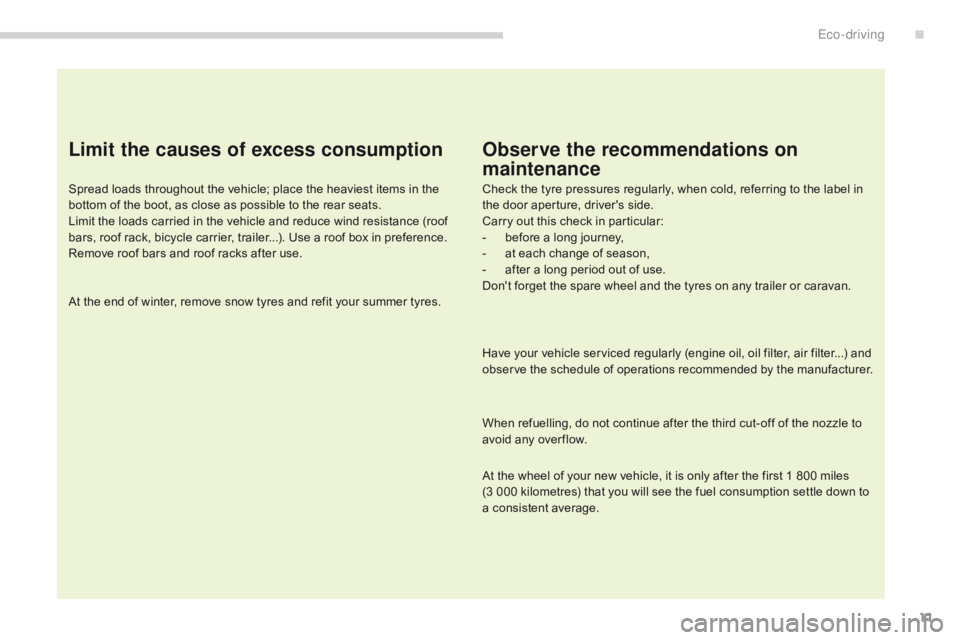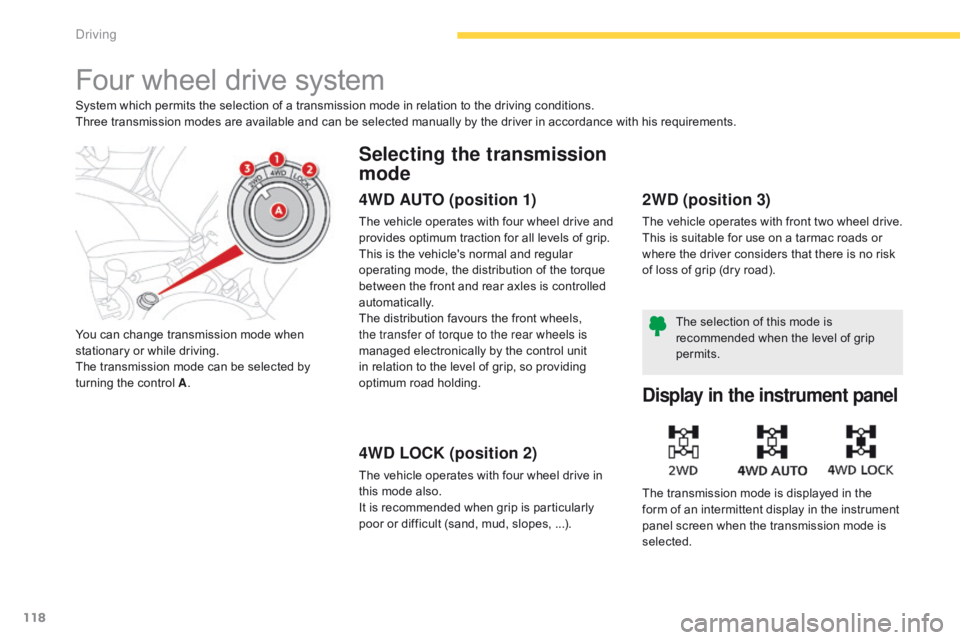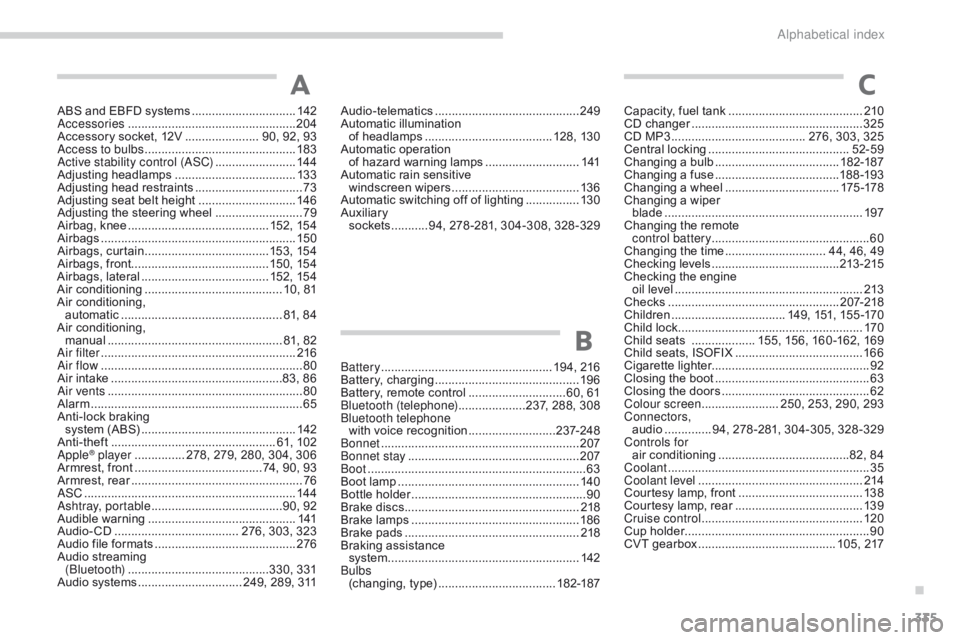change wheel CITROEN C4 AIRCROSS 2021 Handbook (in English)
[x] Cancel search | Manufacturer: CITROEN, Model Year: 2021, Model line: C4 AIRCROSS, Model: CITROEN C4 AIRCROSS 2021Pages: 414, PDF Size: 20.29 MB
Page 13 of 414

11
Limit the causes of excess consumption
Spread loads throughout the vehicle; place the heaviest items in the
bottom of the boot, as close as possible to the rear seats.
Limit the loads carried in the vehicle and reduce wind resistance (roof
bars, roof rack, bicycle carrier, trailer...). Use a roof box in preference.
Remove roof bars and roof racks after use.
At the end of winter, remove snow tyres and refit your summer tyres.
Observe the recommendations on
maintenance
Check the tyre pressures regularly, when cold, referring to the label in
the door aperture, driver's side.
Carry out this check in particular:
-
b
efore a long journey,
-
a
t each change of season,
-
a
fter a long period out of use.
Don't forget the spare wheel and the tyres on any trailer or caravan.
Have your vehicle serviced regularly (engine oil, oil filter, air filter...) and
observe the schedule of operations recommended by the manufacturer.
When refuelling, do not continue after the third cut-off of the nozzle to
avoid any over flow.
At the wheel of your new vehicle, it is only after the first 1 800 miles
(3
000 kilometres) that you will see the fuel consumption settle down to
a consistent average.
.
Eco-driving
Page 30 of 414

28
Screen 1 Screen 2Cause Solution - ActionObservations
Fault with the CVT gearbox. Contact a CITROËN dealer or a
qualified workshop.
The temperature of the four wheel
drive transmission system is too
high. Stop the vehicle and contact
a
CITROËN dealer or a qualified
workshop. The vehicle changes automatically
to two wheel drive (2WD).
The fuel level is low. Refuel as soon as possible.
The low level of the particle
filter additive reservoir has been
reached. Have the reservoir topped up as
soon as possible by a CITR
oËn
dealer or a qualified workshop. Only for the 1.6 litre HDi engine.
+ Start of saturation of the particle
f i l t e r.
As soon as the driving conditions
allow, regenerate the filter by driving
at a speed of at least 25 mph
(40
km/h) for around 20 minutes (with
the 1.6
litre HDi engine the minimum
speed is 36 mph (60
km/h)).If the message remains on, contact
a CITROËN dealer or a qualified
workshop.
The particle filter is faulty. Stop as soon as it is safe to do so.Contact a CITROËN dealer or
a
qualified workshop as soon as
possible.
Monitoring
Page 81 of 414

79
Rear view mirror
Adjustable mirror providing a central rear ward view.
Equipped with an anti-dazzle system, which darkens the mirror glass and reduces the nuisance to
the driver caused by the sun, headlamps from other vehicles...
Manual day/night model
Adjustment
F Adjust the mirror so that the glass is directed correctly in the "day" position.As a safety measure, the mirrors should be adjusted to reduce the "blind spot".
In order to ensure optimum visibility
during your manoeuvres, the mirror
lightens automatically when reverse
gear is engaged.
Day / night position
F Pull the lever to change to the "night" anti-dazzle position.
F
P
ush the lever to change to the normal
"day" position.
Automatic day/night model
By means of a sensor, which measures the
light from the rear of the vehicle, this system
automatically and progressively changes
between the day and night uses.
Steering wheel adjustment
F When stationary , lower the control lever
to release the steering wheel adjustment
mechanism.
F
A
djust the height and reach to suit your
driving position.
F
P
ull the control lever to lock the steering
wheel adjustment mechanism.
as a s
afety precaution, these
operations should only be carried out
while the vehicle is stationary.
3
Comfort
Page 102 of 414

100
For diesel vehicles, when
the engine is cold starting
does not take place until the
pre-heater warning lamp has
gone off.
If one of the starting conditions is not
met, a reminder message appears in
the instrument panel screen. In some
circumstances, it is necessary to
turn the steering wheel slightly while
pressing the "
START/STOP " button
to assist unlocking of the steering;
a message warns you when this is
needed.
The presence of the electronic key
in the defined zone is essential. For
reasons of safety, do not leave this area
when the engine is running.
Switching off using the
electronic key
If the vehicle is not immobilised, the
engine will not stop.
This message is displayed
when the driver's door is
opened and the vehicle is not
in "OFF" mode.
F
P
ress the " START/STOP " button again to
change to "OFF" mode.
F
I
mmobilise the vehicle.
F
P
lace the gear lever in neutral for vehicles
fitted with a manual gearbox, or on P for
vehicles fitted with a CVT gearbox.
F
W
ith the electronic key inside the vehicle,
press the " START/STOP " button.
The engine stops.
The steering locks when a door is opened or on
locking the vehicle.
Each attempt at starting takes around
15 seconds. If the engine does not start, press
the "
START/STOP " button once more to try
again.
The presence of the electronic key in
the vehicle is essential for switching
on the ignition and starting only. Once
the engine has started,
make sure
that the electronic key remains with
the vehicle until the end of the journey:
other wise you would not be able to lock
the vehicle.
Switching off the engine leads to a loss
of braking assistance.
driving
Page 116 of 414

114
The tyre under-inflation detection
system is an aid to driving which does
not replace the need for vigilance on
the part of the driver.
Under-inflation detection
System which continuously and automatically checks the pressures of the four tyres after switching on the ignition.
A pressure sensor is located in the valve of each tyre (except the spare wheel).
The system triggers an alert if a drop in pressure is detected in one or more tyres, compared to the reference pressure registered in the system.
This reference pressure must be reinitialised every time the tyre pressures are adjusted or a wheel changed.
The system operates on condition that sensor identifiers have first been memorised in the system by a CITROËN dealer or a qualified workshop.
You can memorise two sets of tyres (for example: wheels with "standard" tyres and wheels with "winter" tyres).
Driving with under-inflated tyres
increases fuel consumption.This system does not avoid the need
to check the tyre pressures regularly
(including the spare wheel) and before
a long journey.
Driving with under-inflated tyres
adversely affects road holding,
extends braking distances and causes
premature tyre wear, particularly under
arduous conditions (vehicle loaded,
high speed, long journey).
The tyre pressures for your vehicle can
be found on the tyre pressure label (see
the "Identification markings" section).
The tyre pressures must be checked
when the tyres cold (vehicle stopped
for 1 hour or after driving for less then
6 miles (10 km) at moderate speed).
Other wise, add 0.3 bar to the values
indicated on the label.
driving
Page 120 of 414

118
Four wheel drive system
System which permits the selection of a transmission mode in relation to the driving conditions.
Three transmission modes are available and can be selected manually by the driver in accordance with his requirements.
You can change transmission mode when
stationary or while driving.
The transmission mode can be selected by
turning the control A.
Selecting the transmission
mode
4WD AUTO (position 1)
The vehicle operates with four wheel drive and
provides optimum traction for all levels of grip.
This is the vehicle's normal and regular
operating mode, the distribution of the torque
between the front and rear axles is controlled
automatically.
The distribution favours the front wheels,
the transfer of torque to the rear wheels is
managed electronically by the control unit
in relation to the level of grip, so providing
optimum road holding.
4WD LOCK (position 2)
The vehicle operates with four wheel drive in
this mode also.
It is recommended when grip is particularly
poor or difficult (sand, mud, slopes, ...).
2WD (position 3)
The vehicle operates with front two wheel drive.
This is suitable for use on a tarmac roads or
where the driver considers that there is no risk
of loss of grip (dry road).
Display in the instrument panel
The transmission mode is displayed in the
form of an intermittent display in the instrument
panel screen when the transmission mode is
selected.The selection of this mode is
recommended when the level of grip
permits.
Driving
Page 179 of 414

177
Removing a wheel
Parking the vehicle
Immobilise the vehicle where it does not
block traffic: if possible, park the vehicle
on level, stable and non-slippery
ground.
Apply the parking brake, switch off the
ignition and engage first gear to lock
the wheels.
If necessary, place a chock under the
wheel diagonally opposite the wheel to
be changed.
Never go underneath a vehicle raised
using a jack; use a stand.
List of operations
F If your vehicle is equipped with security wheel bolts (equipment available as an
accessory) fit the security socket 5 on the
wheelbrace 1 to slacken the security bolt.
F
S
lacken the other bolts using the
wheelbrace 1 o n l y.
7
Practical information
Page 180 of 414

178
F Place the jack 2 in contact with one of the two front A or rear B locations provided on
the underbody, whichever is closest to the
wheel to be changed.
F
E
xtend the jack 2 until its base plate is in
contact with the ground. Ensure that the
centreline of the jack base plate is directly
below the location A or B used. F
Ra ise the vehicle until there is sufficient
space between the wheel and the ground
to admit the spare (not punctured) wheel
easily.
F
R
emove the bolts and store them in a clean
place.
F
R
emove the wheel.
Practical information
Page 337 of 414

335
ABS and EBFD systems ...............................14 2ac
cessories .............................. ....................204
Accessory socket, 12V
...................... 9
0, 92, 93
a
ccess to bulbs
............................................. 18
3
ac
tive stability control (
aS
C)
........................14
4
Adjusting headlamps
.................................... 13
3
Adjusting head restraints
................................73
A
djusting seat belt height
.............................14
6
Adjusting the steering wheel
..........................79
A
irbag, knee
.......................................... 15
2, 15 4
Airbags
...............
........................................... 150
Airbags, curtain
..................................... 15
3, 15 4
Airbags, front......................................... 150, 15 4
Airbags, lateral
...................................... 15
2, 15 4
Air conditioning
...............................
.......... 10, 81
Air conditioning, automatic
................................................ 8
1, 84
Air conditioning, manual
...............
..................................... 81, 82
ai
r filter
...............
........................................... 216
ai
r flow
..............................
..............................80
Air intake
...............
....................................83, 86
ai
r vents
..............................
............................80
Alarm
............................................................... 65
A
nti-lock braking
system (ABS)
.............................................. 14
2
Anti-theft
..............................
................... 61, 102
apple® player ............... 278, 279, 280, 304, 306
Armrest, front ...................................... 7 4, 90, 93
Armrest, rear
................................................... 76aSC ........
....................................................... 14 4
ash
tray, portable
.......................................9
0, 92
Audible warning
............................................ 1
41
Audio-CD
..............................
....... 276, 303, 323
Audio file formats
.......................................... 2
76
Audio streaming (
b
lu
etooth)
..............................
............330, 331
Audio systems
............................... 2
49, 289, 311Audio-telematics
...............................
............
249
Automatic illumination of headlamps
...................................... 1
28, 130
Automatic operation
of hazard warning lamps
............................
1
41
Automatic rain sensitive windscreen wipers
...................................... 13
6
Automatic switching off of lighting
................
13
0
Auxiliary
sockets
...........9
4, 278 -281, 304-308, 328 -329
AC
Capacity, fuel tank ..............................
..........210
CD changer ............................... ....................325
CD MP3
................
........................ 276, 303, 325
Central locking
.......................................... 5
2-59
Changing a bulb
..................................... 18
2-187
Changing a fuse
..................................... 1
8 8 -19 3
Changing a wheel
...............................
...175 -178
Changing a wiper blade
...............
............................................ 197
Changing the remote control battery ............................................... 60
Changing the time
.............................. 4
4, 46, 49
Checking levels
...................................... 21
3 -215
Checking the engine oil level
...............
......................................... 213
Checks
...............
.................................... 2 07-218
Children
...............................
... 149, 151, 155 -170
Child lock
...............................
........................170
Child seats
................... 1
55, 156, 160 -162, 169
Child seats, ISOFIX
...................................... 16
6
Cigarette lighter............................................... 92
Closing the boot
...............................
...............63
Closing the doors
...............................
.............62
Colour screen
....................... 2
50, 253, 290, 293
Connectors, audio
.............. 9
4, 278 -281, 304-305, 328 -329
Controls for air conditioning
...............................
........82, 84
Coolant
...............................
.............................35
Coolant level
..............................
...................214
Courtesy lamp, front
..................................... 13
8
Courtesy lamp, rear
...................................... 13
9
Cruise control
................................................ 12
0
Cup holder
...............................
........................90
CVT gearbox
......................................... 1
05, 217
bat
tery
...............................
.................... 194, 216
Battery, charging
...............................
............ 19 6
Battery, remote control
.............................6
0, 61
bl
uetooth (telephone)
....................2
37, 288, 308
bl
uetooth telephone
with voice recognition
.......................... 2
37-24 8
bo
nnet
...............
............................................ 207
bo
nnet stay
................................................... 2
07
b
oot
........
......................................................... 63
Boot lamp
...................................................... 14
0
Bottle holder
...............................
..................... 90
Brake discs
.................................................... 2
18
Brake lamps
...............................
................... 18 6
Brake pads
...............................
..................... 218
Braking assistance system
................
......................................... 142
bulb
s
(changing, type)
................................... 18
2-187
B
.
alphabetical index
Page 370 of 414

175
7
Practical information
C4-Aircross-add_en_Chap07_info-pratiques_ed01-2015
Changing a wheel
The tools are stowed in the boot under the floor. To gain access to them: Open the boot. Lift and remove the boot floor.
Access to the vehicle's tools
List of tools
These tools are specific to your vehicle. Do not use them for anything else. 1. Wheelbrace. Used to remove the wheel trim and the wheel fixing bolts. 2. Jack. Used to raise the vehicle. 3. Handle. Used to operate the jack. 4. Removable towing eye. See "Recovering the vehicle".
5. Socket for security wheel bolts (available as an accessory). Used to adapt the wheelbrace to the special "security" wheel bolts.
Procedure for replacing a faulty wheel with the spare wheel using the tools supplied with the vehicle.
The jack must only be used to change a wheel with a damaged tyre. The jack does not require any maintenance.
The jack meets the European standard as defined in Directive 2006/42/CE on machinery. The declaration of conformity can be found at the end of this document. The name and complete address of the manufacturer or, as appropriate, their representative, together with the designation of the jack are given in this certificate of conformity.